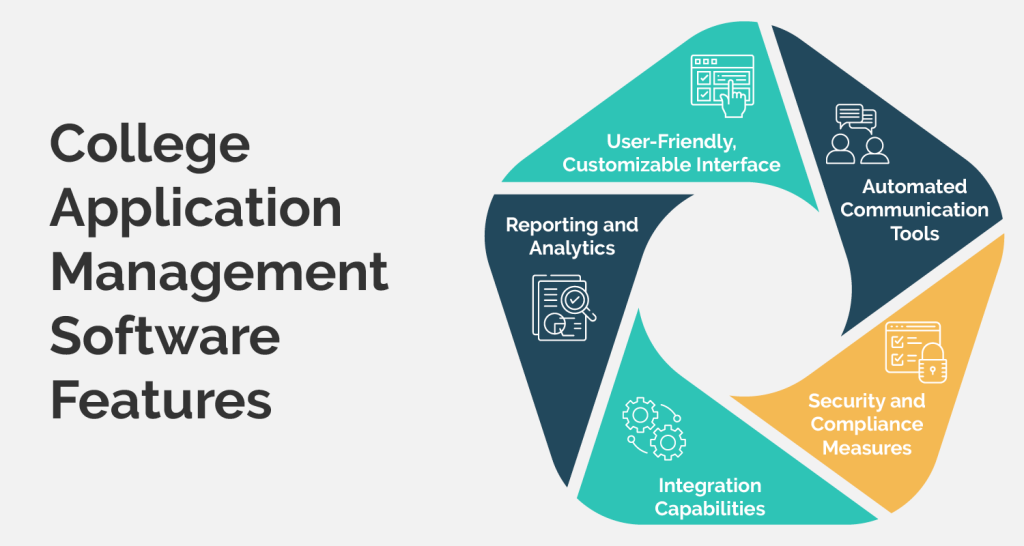
In the United States, the number of college applications is trending upward. For the 2023-2024 academic year, more than 1.2 million prospective students submitted applications using the Common Application, and each student applied to an average of 5.7 schools. So, if you’ve noticed an uptick in applications to your school, you aren’t alone!
Your admissions department needs to leverage the right tools to effectively manage all of these applications, make data-driven decisions, and respond to prospective students in a timely manner. However, with all of the software options available, it can be challenging to choose the right system for your college or university.
If you aren’t sure where to start your search, you’re in the right place! This guide will cover five essential features you should look for in your college application management platform:
Keep in mind that you might have to invest in more than one solution to get all of the tools you need to power your school’s unique admissions setup. Plus, according to Acceptd, “Particular programs or departments [at your university] may also need their own tailored management software depending on their application processes.” However, the five features we’ll review in this guide are a good starting point for any college or university to consider.
1. User-Friendly, Customizable Interface
Your admissions staff are busy, so make sure your application management software offers a streamlined user experience. Anyone who needs to access the platform should be able to navigate and work within it after some basic training. It should also have customization capabilities that allow you to adapt it to your school’s needs.
When considering your management solution’s interface, here are some specific things to look for:
- An organized format so you can quickly find any information or documents you need.
- Drag-and-drop editing tools, as they’re typically the easiest to use for beginner software users.
- The ability to tailor the application process in various ways, such as sorting essay responses to program-specific questions or uploading information from admissions interviews.
While your platform should be user-friendly, make sure it also has built-in technical support in case issues arise or staff members have additional questions after their training. This tech support team should also be able to help applicants if issues arise on their end—a positive user experience is also important for them!
2. Automated Communication Tools
Once prospective students submit their applications to your college, they expect to hear back by the decision deadline you promised (or within a few weeks if you do rolling admissions). To stick to these deadlines, you’ll need to contact applicants promptly to resolve any issues and update them on their status.
This is where automated communication tools come in handy. Some of the specifics to look for with these include:
- Segmented contact lists. Organize applicants’ email addresses and phone numbers based on the program or major they’re applying to, their application status, and more to ensure the right messages reach the right people.
- Schedule send and automatic delivery. Write emails when you have the time to do so, schedule them for the intended delivery date, and rest assured that your messages actually made it to applicants’ inboxes.
- SMS capabilities. Meet prospective students where they likely already are—on their phones—and get in touch with them at a moment’s notice.
If you can find automated communication tools that are also suitable for recruitment and post-acceptance communications, your investment in them will be even more valuable.
3. Security and Compliance Measures
When prospective students submit their college applications, they share a lot of sensitive personal information with your school. Your management software needs to comply with security standards to reassure applicants that this information will remain confidential.
Ensure the following security measures are included in your software:
- Encryption to make your document storage system harder to breach.
- Two-factor authentication and strong password requirements for all user accounts.
- A PCI-compliant payment processor so you can quickly and safely accept and transfer application fees.
Additionally, include a rundown of data security best practices when you train your staff on how to use the application management platform to keep them top of mind.
4. Integration Capabilities
As previously mentioned, your school will likely need to leverage a few different solutions to manage its applications effectively. To allow for smooth information transfer and accurate analysis, those platforms should work together as a unified system through software integrations.
Your main college application management software should integrate with the following platforms:
- Customer relationship management (CRM) solutions for permanent data storage.
- Student information systems (SIS) to quickly transfer accepted applicants’ information once they commit to your school.
- Learning management systems (LMS) so students can get set up for their classes.
- Financial aid software so you can provide an accurate estimate of applicants’ attendance costs when you accept them.
The management platform should also integrate with department-specific solutions so that if a specific program has a unique aspect of its acceptance process, the information from that element can be combined with the student’s main application to make the final decision. For example, your performing arts program will need to integrate its audition scheduling tool and virtual audition platform with your school-wide solution since students in those majors have to audition as well as apply.
5. Reporting and Analytics
When it comes to college application management, software integrations work together with effective reporting to prevent data from becoming siloed. According to Redpath Consulting Group, “To give students the best educational experience possible and ensure you’re addressing their needs, you need a unified software solution that gives faculty and staff easy access to the full picture.”
To get this complete picture with your application software, look for data management capabilities such as:
- Comprehensive, organized storage systems
- A wide variety of accessible data analytics
- Custom report generation and downloads
These features will help you gain deeper insights into your college’s application process so you can understand what is going well and where there is room for improvement.
The features in this guide are just five of the many possible functions you might look for in college application management software, as the correct combination of capabilities for your school will depend on your needs and goals. Weigh the benefits of several management solutions and confirm your software budget before choosing the platform—or platforms—that will best suit your school.
